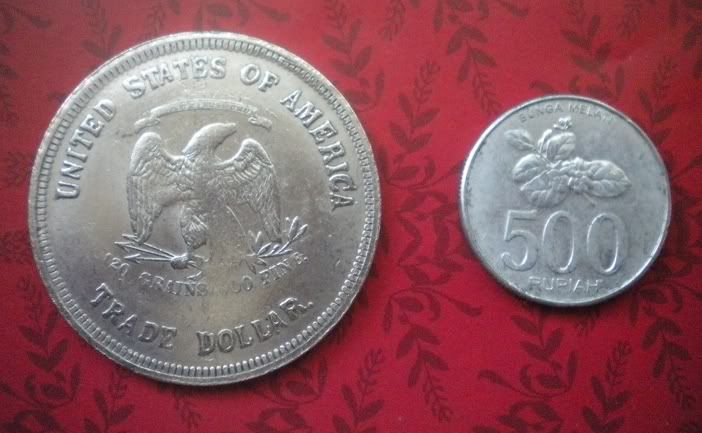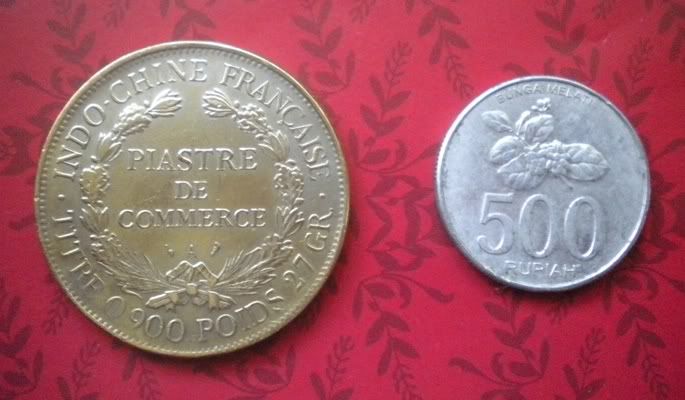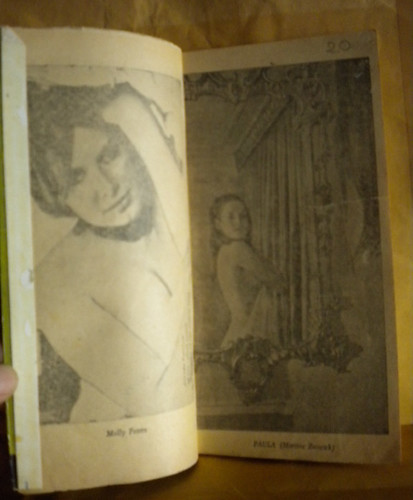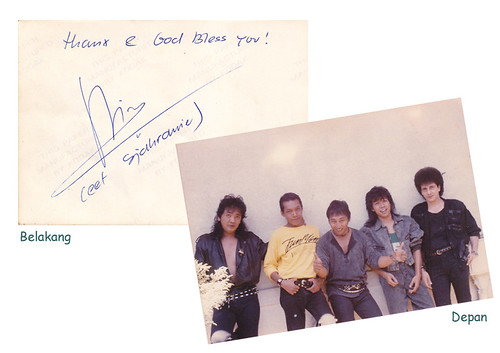| Nice Silver Trade Dollar, "United States of America - Trade Dollar - 420 Grains 900 Fine - 1878 Tahun : 1878 Harga : Rp. 400.000,- |
Trade dollar (United States coin)
The trade dollar was a United States dollar coin minted to compete with other large silver coins that were already popular in the Orient. The idea first came about in the 1860s, when the price of silver began to decline due to increased mining efforts in the western United States. A bill providing in part for the issuance of the trade dollar was eventually put before Congress, where it was approved and later signed into law as the Coinage Act of 1873. The act made trade dollars legal tender up to five dollars. A number of designs were considered for the trade dollar, and an obverse and reverse created by William Barber were selected.
The coins were first struck in 1873, and most of the production was sent to China. Eventually, bullion producers began converting large amounts of silver into trade dollars, causing the coins to make their way into American commercial channels. This caused frustration among those who were given them in payment, as the coins were largely maligned and traded for less than one dollar each. In response to their wide distribution in American commerce, the coins were officially demonetized in 1876, but continued to circulate. Production of business strikes ended in 1878, though the mintage of proof coins continued until 1883. The trade dollar was remonetized when the Coinage Act of 1965 was signed into law.
Background
Following the California gold rush that began in 1849 and the Australian gold rush that began in 1851, a larger amount of gold was put into commerce than could be easily absorbed by the normal channels.[1] This resulted in a decrease in the value of gold and an increase in the value of silver.[1] As a result, silver coins rapidly disappeared from circulation due either to hoarding or melting.[1] In response, Congress authorized the Mint to reduce the quantity of silver in all denominations except the three-cent piece and silver dollar.[1] Beginning in the 1860s, silver production rose and the price decreased.[2] During this time, silver coins largely disappeared from circulation and were replaced by paper and copper currency.[2]
In China, the Mexican peso (successor to the Spanish dollar) was greatly valued in commerce. However, the Chinese were sensitive to any changes in the coin's design, and were reluctant to accept newer coins due to a minor design change. The American silver dollar, 7.5 grains (0.49 g) lighter than its Spanish counterpart, was unpopular in the Orient due to its light weight, forcing American merchants to purchase the Spanish or Mexican pieces to use in trade.[3] Beginning in 1866, during the reign of Emperor Maximilian, the design was changed to show the Emperor's portrait; this caused widespread nonacceptance of the coins in China.[4]
While conducting an investigation of the Mint at San Francisco, deputy comptroller of the currency John Jay Knox began discussing the monetary situation with Louis A. Garnett, a man who had worked as both the treasurer and assayer of the San Francisco Mint.[5] Garnett recommended that the United States mint a commercial dollar that would be exported to the Orient to compete with other large silver coins that were already popular in that region.[5] Garnett's rationale was that the coins would be hoarded or melted in Asia and would never be presented for redemption, allowing the government to make a profit from the seigniorage.[6] During his time in San Francisco, Knox also discussed the proposed commercial dollar with Henry Linderman, who was working as a special agent for the Treasury Department at that time.[5] In 1870, Knox wrote a report to the Treasury and wrote the draft for a bill on coinage.[5] Knox's bill was approved by George Boutwell, Secretary of the Treasury.[5] After modification and review from current and former government officials, the bill was put before Congress.[7]

A group of trade and commercial dollar patterns dated 1872. The two uppermost obverse designs were created by Chief Engraver William Barber, while the lower was created by Christian Gobrecht for the Seated Liberty series.
On February 1872, the bill was amended by a House of Representatives committee to include authorization for a commercial dollar weighing 420 grains (27 g);[7] this was struck three months later when the House voted to include provisions for the production of a standard silver dollar weighing 384 grains (24.9 g).[7] While in the Senate, a provision was added to the bill requiring the Treasury to coin a trade dollar of 420 grains (27 g), as had been done earlier in the House.[7] The revised bill, which came to be known as the Coinage Act of 1873, was approved in the House and Senate and was signed by President Ulysses S. Grant on February 12, 1873.[7] The bill provided, in part, for the striking of trade dollars which held legal tender status up to five dollars.[9] The legal tender provision was added by a last-minute rider at the behest of silver interests.[10] At the insistence of Ohio Senator John Sherman, the weight and fineness of the piece was indicated on the reverse, an attribution which numismatic historian Don Taxay found incomprehensible as "Chinese merchants would never understand them".[11]
Prior to the passage of the Coinage Act, the director of the Philadelphia Mint oversaw all branch mints.[12] After the Act, the office of director was transferred to Washington, D.C. and responsibility for each mint was handed over to a superintendent.[12]
Design selection
Throughout the year of 1872, the Mint struck a series of commercial dollar patterns in anticipation of the passage of the coinage bill.[13] Production of patterns continued into 1873, but the denomination of the pattern coins was changed from "commercial dollar" to "trade dollar" before the bill was signed into law.[13] After passage of the Coinage Act, Linderman met with Director of the Mint James Pollock to discuss the design of the newly authorized trade dollar.[13] The two men agreed to request a jewelry and engraving firm, Bailey Banks & Biddle of Philadelphia, to create designs that would be compared to those already created by Chief Engraver William Barber.[13]
After examining the designs of both parties, Linderman ordered that the design would depict a seated figure representing Liberty facing to the viewer's left, representing the direction of the Orient.[13] Linderman apparently selected the designs from two different patterns.[14] In June 1873, Linderman reviewed the various patterns created by Barber; he chose[15] an obverse which one contemporary reporter described as "a female figure seated on bales of merchandise, holding in her left hand a scroll bearing the word 'Liberty'. At her back is a sheaf of wheat, expressing, with the bales of goods, the commercial character of the coin: the right hand extended holds the olive branch."[16] The selected reverse depicts the bald eagle as required by law.[15] The eagle has three arrows in the right claw and an olive branch in the left, a reversal to most other U.S. silver coins of the era.[17] A set of six patterns, four with variations on the adopted obverse, and two showing portraits of Liberty, was sold by the Mint to the public in limited quantities.[18]















